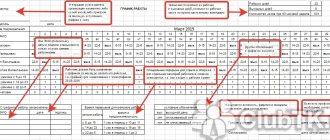The legislation establishes certain days that are considered holidays and, accordingly, are days off. This:
- January 1, 2, 3, 4 and 5—New Year holidays;
- January 7—Christmas Day;
- February 23 - Defender of the Fatherland Day;
- March 8—International Women's Day;
- May 1 - Spring and Labor Day;
- May 9 - Victory Day;
- June 12—Russia Day;
- November 4 is National Unity Day.
It happens that the company has a shift work schedule. In this case, it is permitted to involve employees in work on these days. But pay for shift work on these days differs from regular working days. We will discuss these features below.
Let's make a reservation right away that there are day and night shifts. They are not paid the same.
In general cases, an additional payment of at least 20% of the established rate is made for night shifts.
Description of basic concepts
A shift work schedule is an order in which some workers are replaced by others to perform the same types of work. Moreover, each citizen works on a certain day of the week.
For example, there are two employees, and the schedule is two days after two. For one employee you can set the following as workers:
- For one week, Monday, Tuesday, Friday and Saturday.
- For the second week, Tuesday and Wednesday, Saturday, Sunday.
Such schedules are relevant if the production process at the enterprise does not tolerate long interruptions. Article 103 of the Labor Code of the Russian Federation controls this mode of operation.
It is permissible to introduce two, three, or four shifts. When using this type of schedule, workers are divided into several groups at once. Each of them performs work on certain days and hours.
general information
Carrying out labor activities during shift work is regulated by the Labor Code, and more specifically by Art. 103. According to this regulatory document, a shift schedule should be understood as working in several shifts. This schedule is most often used in industries where the duration of the work process is much longer than the length of the working day. Most often this is:
- Services providing emergency assistance. These are police, ambulance, fire services, Ministry of Emergency Situations, etc.
- Continuous production. The nature of work in such industries does not involve stopping equipment, which is why it is so important to establish a shift work schedule.
- Trade and service. Many restaurants and stores are open 24 hours a day, which means workers have shifts.
- Infrastructure organizations. Shift schedules are also common in various automobile, sea, and river companies.
If an enterprise uses such a regime, this must be indicated in the relevant internal local regulations. Performing work duties during a shift schedule has a number of nuances. For example, you cannot work several shifts in a row. Also, many employers think that the presence of shifts will increase the norm established in production by a special calendar. But it must be borne in mind that scheduling is carried out with the involvement of the trade union. In addition, the shift mode has other features:
- The duration of work cannot be longer than the norm (Article 91 of the Labor Code of the Russian Federation).
- Some categories of subordinates cannot work more than the established limit (Article 94 of the Labor Code of the Russian Federation).
- The pre-holiday work shift should be 1 hour shorter (Article 95 of the Labor Code of the Russian Federation).
- Night shifts are necessarily reduced by one hour (Article 96 of the Labor Code of the Russian Federation).
- Every week, subordinates must rest for at least 42 hours without a break (Article 110 of the Labor Code of the Russian Federation).
By law, a person must perform work duties no more than 40 hours a week. This means that with such a schedule this norm must be taken into account. Exceeding this norm is considered overtime work, which has a different payment procedure.
Payment for holidays during a shift work schedule
Article 153 of the Labor Code states that holiday work shifts require a minimum of double pay. The calculation is carried out taking into account not the entire shift, but the hours that were actually spent performing duties at that moment. There are often shifts that move from one day to the next.
One scheme is used with standard salaries. Then you first need to calculate the average cost of labor for one day. Then the result is multiplied by 2.
Recruitment
Working on a day off is not considered work performed on Saturday or Sunday if the shift falls according to the schedule. But if it falls on a holiday, then payment for it must be made differently. There are often cases when, even with a shift schedule, management has to call a subordinate to work.
The basis for this is the order of the employer. There is no statutory form for such a document, so it can be drawn up in free form. The main thing is that the order contains the employee’s data, the dates when he must return to work, etc. Separately, you can formalize the consent or refusal of a subordinate to perform duties on a holiday. Some employers indicate a special column in the order where the subordinate can indicate his consent or refusal.
Examples of calculations using the two-by-two scheme
Let's look at one example that helps you understand how to pay for holidays, even if they are only part of the schedule.
There is a schedule according to which a subordinate works 12 hours for 16 days. Of the total, two holidays stand out. The rate for one hour of work is 150 rubles.
Two days with 12 hours of work are paid using the double tariff. We multiply 150 by 24 and multiply by 2. The result is 7200.
The rest have 14 days of 12 hours - standard single size. We simply multiply 14, 12 and 150. We get 25,200 rubles.
In total for May, the employee receives a salary consisting of two figures received earlier. The entire amount is issued in person minus income tax at a rate of 13%.
For information on calculating wages during a shift schedule, watch this video:
A little theory
An example of a staggered work schedule is the organization of work for guards - on weekdays the premises only need a security guard at night, but on general weekends his presence is required 24 hours a day. Taking into account the existing standards for the ratio of working and free time, it is rational to schedule employees’ trips to work in advance and immediately for a long period of time (but not more than 1 year). What does flexible work schedule mean? This is a work regime in which floating weekends must be arranged in the calendar taking into account the mentioned standards, so that there is no overtime. The most commonly used schedule is 2 working days every 2 days off. This employment system is regulated by Articles 100 - 105 of the Labor Code of the Russian Federation and local regulations of the organization. It must be prescribed in the internal labor regulations of the organization (ILR).
Rules for increasing the cost of work
Such increases are permissible for employees representing one of the following categories:
- When using the piecework payment option. That is, when the determining factor is the actual quantity of services and goods produced.
- With daily or hourly rates.
- Workers who receive a standard salary.
If an enterprise’s internal documents indicate a smaller amount of payment for holidays than usual, this is a direct violation of current legal requirements. Such decisions are easy to appeal when going to court.
In this case, an employee can choose to receive additional rest if he not only works on weekends and holidays, but also exceeds the established standards for labor results.
Results
Holidays during shift work are paid at least double the amount. Under certain conditions, instead of double pay, an employee can receive single pay and time off. The specific amount of the “holiday” surcharge, the maximum of which is not limited by law, is fixed in the company’s internal local act or industry agreement.
Sources: Labor Code of the Russian Federation
You can find more complete information on the topic in ConsultantPlus. Free trial access to the system for 2 days.
When double pay is replaced by rest
In some situations, subordinates have the right to demand time off instead of double remuneration for holidays worked. The decision in each case is individual and depends on how much time has actually been worked up to the present moment.
Such demands cannot be made only by those who usually work overtime. The same applies to the use of a shift schedule.
How to calculate time worked
Accounting for time worked in this mode is summarized (by week, month, quarter or year). It is convenient if the norm of working time per week is not maintained, but is leveled out when calculated by quarters or months. The main task of the accountant in this case is to figure out how to distribute weekends with the required time generated over a set period. The main condition is that an employee cannot have more than 40 working hours per week. In the case of using the 2/2 system with a 12-hour shift, the employee works 48 hours, which exceeds the weekly norm, which means that he must have another floating day off.
How to organize work according to a schedule
An employer planning to establish a staggered schedule must take a number of actions:
- determine the accounting period of working time (month, quarter, year), set working hours (using the 2/2 mode in a 12-hour format will entail overtime due to the fact that there will be 42 hours of work per week when 40 hours are allowed, therefore in the accounting period additional days off should be provided for a specific employee);
- determine the names of positions for which a special regime is introduced;
- determine the number of employees per workplace;
- determine the sequence of weekends and working days;
- check the legality of establishing such a format for a specific employee, that is, determine whether the employee belongs to a category for which there are special legal requirements (indication of the start and end times of work, rest and meal breaks, alternating days of work and rest);
- issue an administrative document establishing the work regime of the institution (there is no template for the document form, it is necessary to familiarize all employees, establish an accounting period - from a week to a year);
- establish working hours and rest time in the PVTR or employment agreement (in this case, the document reflects the employee’s full name and the sequence of weekends and working days) in the absence of special requirements;
- sign an employment contract with an employee, specifying the definition of a special regime for him (enter information about the schedule in the “Work and rest regime” section), when hiring, or sign an additional agreement if it is necessary to determine the work regime during the work process;
- develop a sequence (for example, distribute workdays and weekends throughout the month in a 2/2 format);
- fix rest days.
How to pay on holidays
It is simply impossible to avoid working on holidays with a rotating schedule - there are enough of them in the production calendar.
Time off on holidays is considered outside normal working conditions (Article 149 of the Labor Code of the Russian Federation). According to this regulation, holiday work must be paid additionally.
Art. 153 of the Labor Code of the Russian Federation explains what payment an employee has the right to expect:
- For piece workers - no less than double the piece rate.
- For employees on an hourly or daily rate, no less than double the corresponding rate.
- If an employee receives a fixed amount each month, then work on a holiday within the limits of work for the month or quarter is paid no less than a single rate in addition to salary.
- If an employee receives a fixed amount each month, working on a holiday outside of the monthly or quarterly work rate will be paid no less than twice the rate in addition to salary.
The article contains a note that the employer has the right to independently determine the amount of incentives for going on vacation. The only condition is that the salary for working on holidays should not be less than the norms established by law.
It happens that, in addition to going out on holidays, the shift also affects night work. Then the employee will have to pay two additional payments:
- For work on a holiday (Article 153 of the Labor Code of the Russian Federation).
- For work at night (Article of the Labor Code of the Russian Federation).
In accordance with the Government Decree “On the minimum increase in wages for night work” No. 554 of July 22, 2008, the night shift is 8 hours: from 22:00 to 06:00. For every hour worked at night, the employee receives an additional minimum of 20% of the regular rate. Then the payment will be calculated as follows:
- Hours actually worked at double the wage rate (except in cases where the employee prefers to take a day off instead of compensation payments).
- The amount of pay for each hour worked during the holidays at night increases by at least 20%.
Features of remuneration
Throughout the entire accounting period, the employer must ensure that the norm provided for by law is fulfilled. If the number of hours is less, this is a deficiency and, in accordance with Article 234 of the Labor Code of the Russian Federation, the employee is entitled to compensation for unused hours. The size of the payment is determined based on average earnings.
For reporting and further calculations, the organization must maintain a record sheet. It contains information about the actual number of hours worked.
Salary can be determined by the tariff rate or by the monthly salary. If a salary is established, then the established norm is taken into account. If it is fully fulfilled, the salary is equal to the salary. The salary is also paid in full if the planned number of hours is less than the norm.
When paying a tariff, the number of hours is multiplied by the rate.
In addition to the basic salary, other incentive payments and bonuses may be established by the employment contract or local regulations.
Employment on a shift schedule often involves working under special conditions - at night, on holidays. In this case, special calculation rules apply.
Using a sliding schedule
Its use is optimal when the company does not need a regular five- or six-day week. The sliding option makes it possible to optimize human resources, as well as establish the most economical work cycle.
Examples of types of work where this format is often used are:
- Selling organizations. For many stores, it is not practical to introduce a 24-hour shift schedule, and there is a need to organize production throughout the week, but seven days a week. The duration of the working day, as a rule, is no more than 8 hours, that is, the standard five-day period.
- Security organizations. The operating principles of security companies are similar to the previous version. It is necessary to ensure the security of an institution during its work, but there is no practicality in protecting it during non-working hours with a similar number of employees.
- Communication organizations, consultants. In the course of the activities of organizations, it is sometimes necessary to ensure continuous activity of consultants throughout the week, and the continuous format is the most suitable.
Thus, the need to use a rolling format depends on a number of factors, including the inability to introduce other activity algorithms in the organization. At the same time, you need to understand that work activities in such a format are, as a rule, not relevant for managers.









